

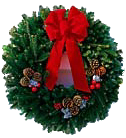
Christmas Store
The holidays are just around the corner so now is the time to fetch the finest gifts for the Labrador Lover on your Christmas list. We have over 100 gifts $50.00 and under. Visit our Christmas Store.
For the Lab
Bedding
Coats
Collars and Leads
Dog Bowls
Feeding Stations
Spa and Grooming
Toys and Treats
Travel and Accessories
For the Lab Lover
Apparel
Cards and Giftwrap
Fine Accessories
Gifts and All Occasions
Jewelry
Kids Only
For the Lab Home
Artwork
Books
Garden and Outdoor
Home Furnishings
Kitchen Accessories
Pillows, Throws, and Rugs
Gift ServicesGift Boxes
Gift Certificates
Ivan the AgilE
By Regan Michelle White
In a sport largely dominated by herding breeds such as Border Collies, six and a half year-old black Lab “MACH Ophir’s Ivan” stands out as one of the top agility Labrador Retrievers in the US. For Ivan and his owner Greg Fontaine however, the title is just the icing on the cake. It’s the relationship that’s formed from their time together and their adventures in training that provides the greatest reward.
Dog agility is a competitive sport that tests a person’s skills in the training and handling of their dog over a timed obstacle course. Competitors race against the clock as they direct their dogs to jump hurdles, scale ramps, burst through tunnels, traverse a see-saw and weave through a line of poles in an obstacle course configuration where both speed and accuracy are judged. Agility tests the dog’s ability to maneuver quickly through these obstacles while focusing on the handler’s directions. For Greg and Ivan, these challenges provide an adrenaline pumped opportunity to have some fun.
Ivan, Greg’s first dog, came from breeder Jenny Eppinga of Ophir’s Labradors outside of Atlanta, Georgia. When asked why he chose a Lab, Greg states matter-of-factly: “I wanted a buddy. I had heard and read a lot about the great temperament Labs have and that was just what I was looking for.” As for the name Ivan, Greg adds, “I wanted him to have a serious name. Not necessarily so serious, but I didn’t want people to treat him like a goofball the way I see some dogs treated.” Indeed, it seems rather hard to imagine: Master Agility Champion … Ophir’s Cookie Dough, whereas Ivan’s name truly lives up to his success.
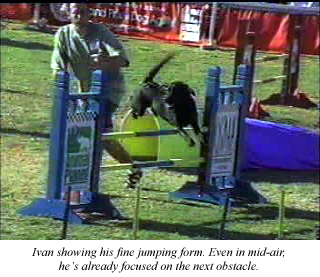 Greg openly admits that he started agility competition with Ivan way too early, when his Lab was just a little over one year of age. Greg says, “I wouldn’t recommend that anyone start competing that early. I just didn’t know any better at the time, but I wouldn’t do it again. There is more to it than just running around on the equipment. There are so many skills to teach and some of my training got in the way so that I had to go back later on and re-train.”
Greg openly admits that he started agility competition with Ivan way too early, when his Lab was just a little over one year of age. Greg says, “I wouldn’t recommend that anyone start competing that early. I just didn’t know any better at the time, but I wouldn’t do it again. There is more to it than just running around on the equipment. There are so many skills to teach and some of my training got in the way so that I had to go back later on and re-train.”
What Greg does recommend however is to work on the life skills that pups need. As he says, “If you work on their life skills while they are young, the agility stuff will come. There’s not much point trying to teach more involved behaviors if the pup doesn’t yet default to looking to you for reinforcement. If you can’t help the pup modulate its arousal, anxiety, nervousness and excitement then you can’t direct its energy into sharing an activity together with you.”
Once this daily life foundation is established, Greg recommends teaching all sorts of different behaviors that will serve as a foundation for competing, such as: body awareness work, various exercises to teach them how to use their rear legs while moving, how to move more balanced and increase their coordination on equipment such as ladders, perches, very low cavalettis and wobble boards. He stresses that all of these should be taught as fun games and as a means to increase skill, confidence, and the connection between the dog and the trainer. He adds, “However, I wouldn’t be jumping the pups or sending the pups through sets of weave poles or attempting to sequence obstacles together at least until after the pup’s growth plates had closed, usually around 14 months of age.”
As far as how Greg got involved in agility training to begin with, initially he had never even heard of it. When he got Ivan he knew that he wanted to do something special with him: “I had heard enough and read enough about different kinds of training that I knew I wanted to do something more than just sit around with him. I wanted to relate to him. I wanted to have something that would teach us about each other and give us something to do together and work on together.” He also received valuable training insight from his breeder. As fate would have it, while Greg and Ivan (6 or 7 months old at the time) were waiting to get into an obedience class, they took an agility class in between. From then on their focus on agility training kind of took over.
When asked how often he and Ivan have to train, Greg replies, “‘Have to’ is not part of it. Training is just part of our day. As far as competitions go, we could take them or leave them. On average we train five days a week. It doesn’t take long at all and it’s our time together. We’ll train for five minutes at a time and take a break, then maybe train for a couple more minutes.” Greg constructs a series of different games that focus on various training challenges and new skills for Ivan. On the day of our interview, Greg’s five minute training focused on accomplishing two goals with Ivan: restructuring the way he retrieves a toy (so that he will return with the toy on his own will without having to call him or use the lure of another toy) and working on getting Ivan to move ahead of Greg through a series of obstacles (instead of alongside).
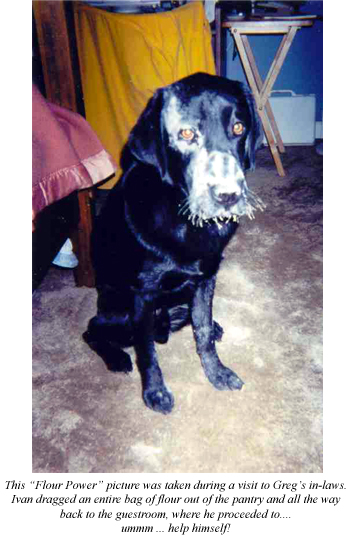 When asked what Ivan is best at doing and what he struggles with, Greg answers that, “Ivan is absolutely best at eating food. I understand that this is a largely universal Lab trait.” In regards to Ivan’s favorite food, Greg says, “Oh, anything. He doesn’t taste it long enough to know...he likes whatever there’s more of!” With agility training, Greg says, “Ivan is definitely the best at giving his all, with great intensity. In terms of equipment, our dog walks are excellent. We do a great running dog walk. The weave poles are definitely the toughest for Ivan. He’s not huge, but he’s a normal sized full-grown Lab so the tight turning back and forth between the weave poles is always a challenge for him, just based on his breed.”
When asked what Ivan is best at doing and what he struggles with, Greg answers that, “Ivan is absolutely best at eating food. I understand that this is a largely universal Lab trait.” In regards to Ivan’s favorite food, Greg says, “Oh, anything. He doesn’t taste it long enough to know...he likes whatever there’s more of!” With agility training, Greg says, “Ivan is definitely the best at giving his all, with great intensity. In terms of equipment, our dog walks are excellent. We do a great running dog walk. The weave poles are definitely the toughest for Ivan. He’s not huge, but he’s a normal sized full-grown Lab so the tight turning back and forth between the weave poles is always a challenge for him, just based on his breed.”
Greg feels that he and Ivan have been lucky in that they have seen a great amount of success in a discipline that they love, regardless of competition. The pair has competed extensively however, in both American Kennel Club (AKC) and United States Dog Agility Association (USDAA) events. In the AKC agility competitions, Ivan has received his MACH or Master Agility Champion title – the highest that can be achieved in AKC agility. In the USDAA competitions, Ivan has competed at the Grand Prix Nationals. Ivan made it to two consecutive National finals, in 2001 and 2002, finishing fifth overall one of those two years. Greg says with a laugh, “The other year, I fell down thereby throwing Ivan off course.” When asked about how he finds competing against a bunch of different breeds, with different advantages and disadvantages in the same competition, Greg says, “I like it. I’d rather have it all different breeds. I think it would be pretty boring just looking at one dog over and over again in competition. You really learn by seeing the differences.”
Greg and Ivan have a relatively light competitive schedule throughout the year compared to some. Last year, they competed at 14 trials, averaging just over one a month. As Greg says, “I just like to see what we have. It’s always such a long weekend when you’re at a competition and we like to train and play more than anything.” Greg and Ivan live in Asheville, NC with Greg’s wife, Dudley and her three standard poodles that she in turn does agility, tracking, obedience and hunt test training & trials with. Greg says of his wife, “She really is a ‘jack of all trades.’ She used to ride and train horses competitively, so I’ve learned a lot from her about how animals jump and how to apply that to my own training with Ivan. We’re both nuts about dogs and about training. It would be hard for someone who isn’t nuts about it to understand where we’re coming from or why I obsess over one little detail in playing with my dog. It’s really nice to be able to share that understanding.”
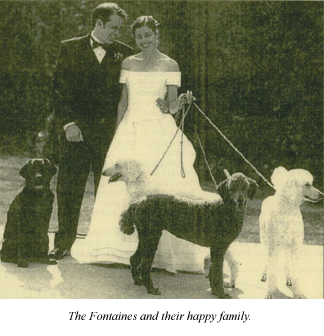 When Ivan’s not training or competing, in the words of his owner, “He likes to eat … or lie on the couch. He’s a real couch potato when he’s home. He also likes to bring me my shoes, or my wife’s shoes, or my keys if I’ve left them somewhere – anything to get me started.” When Greg’s not training or competing with Ivan, he practices residential real estate law.
When Ivan’s not training or competing, in the words of his owner, “He likes to eat … or lie on the couch. He’s a real couch potato when he’s home. He also likes to bring me my shoes, or my wife’s shoes, or my keys if I’ve left them somewhere – anything to get me started.” When Greg’s not training or competing with Ivan, he practices residential real estate law.
Despite their achievements, Greg stresses that, “what feeds me is that I enjoy the everyday of it. Ivan and I have been lucky to have competitive success, but that isn’t what sustains you. The competitive success isn’t what fires me up to go out and do it every day. It’s our interaction together.” And that’s a winning combination.
Tail End:
Agility is fun for both the dog and the handler. Dogs gain confidence in their ability to master each obstacle plus they love the freedom of running, jumping and crawling through the challenges. Handlers must also physically navigate the course in order to give the precise physical and verbal cues that direct their dog to the next obstacle, developing an incredibly strong bond with their four footed team member.
Agility events are organized in different ways, depending on which organization is hosting the competition. “All breed” agility trials are open to any AKC breed while Specialty trials are restricted to dogs of a specific breed or sometimes to a “group” such as the Sporting Group (which Labs belong to.) There are also different divisions, or classes, within these competitions, based on the type of obstacle course, difficulty and also the height of the dog- in order to make the competition equal between the different sizes of dogs.
For more on agility training and competition, we invite you to visit:
The American Kennel Club (AKC)
and
The United States Dog Agility Association
Click here to go back to Lab of the Month
By Regan Michelle White
In a sport largely dominated by herding breeds such as Border Collies, six and a half year-old black Lab “MACH Ophir’s Ivan” stands out as one of the top agility Labrador Retrievers in the US. For Ivan and his owner Greg Fontaine however, the title is just the icing on the cake. It’s the relationship that’s formed from their time together and their adventures in training that provides the greatest reward.
Dog agility is a competitive sport that tests a person’s skills in the training and handling of their dog over a timed obstacle course. Competitors race against the clock as they direct their dogs to jump hurdles, scale ramps, burst through tunnels, traverse a see-saw and weave through a line of poles in an obstacle course configuration where both speed and accuracy are judged. Agility tests the dog’s ability to maneuver quickly through these obstacles while focusing on the handler’s directions. For Greg and Ivan, these challenges provide an adrenaline pumped opportunity to have some fun.
Ivan, Greg’s first dog, came from breeder Jenny Eppinga of Ophir’s Labradors outside of Atlanta, Georgia. When asked why he chose a Lab, Greg states matter-of-factly: “I wanted a buddy. I had heard and read a lot about the great temperament Labs have and that was just what I was looking for.” As for the name Ivan, Greg adds, “I wanted him to have a serious name. Not necessarily so serious, but I didn’t want people to treat him like a goofball the way I see some dogs treated.” Indeed, it seems rather hard to imagine: Master Agility Champion … Ophir’s Cookie Dough, whereas Ivan’s name truly lives up to his success.
 Greg openly admits that he started agility competition with Ivan way too early, when his Lab was just a little over one year of age. Greg says, “I wouldn’t recommend that anyone start competing that early. I just didn’t know any better at the time, but I wouldn’t do it again. There is more to it than just running around on the equipment. There are so many skills to teach and some of my training got in the way so that I had to go back later on and re-train.”
Greg openly admits that he started agility competition with Ivan way too early, when his Lab was just a little over one year of age. Greg says, “I wouldn’t recommend that anyone start competing that early. I just didn’t know any better at the time, but I wouldn’t do it again. There is more to it than just running around on the equipment. There are so many skills to teach and some of my training got in the way so that I had to go back later on and re-train.”What Greg does recommend however is to work on the life skills that pups need. As he says, “If you work on their life skills while they are young, the agility stuff will come. There’s not much point trying to teach more involved behaviors if the pup doesn’t yet default to looking to you for reinforcement. If you can’t help the pup modulate its arousal, anxiety, nervousness and excitement then you can’t direct its energy into sharing an activity together with you.”
Once this daily life foundation is established, Greg recommends teaching all sorts of different behaviors that will serve as a foundation for competing, such as: body awareness work, various exercises to teach them how to use their rear legs while moving, how to move more balanced and increase their coordination on equipment such as ladders, perches, very low cavalettis and wobble boards. He stresses that all of these should be taught as fun games and as a means to increase skill, confidence, and the connection between the dog and the trainer. He adds, “However, I wouldn’t be jumping the pups or sending the pups through sets of weave poles or attempting to sequence obstacles together at least until after the pup’s growth plates had closed, usually around 14 months of age.”
As far as how Greg got involved in agility training to begin with, initially he had never even heard of it. When he got Ivan he knew that he wanted to do something special with him: “I had heard enough and read enough about different kinds of training that I knew I wanted to do something more than just sit around with him. I wanted to relate to him. I wanted to have something that would teach us about each other and give us something to do together and work on together.” He also received valuable training insight from his breeder. As fate would have it, while Greg and Ivan (6 or 7 months old at the time) were waiting to get into an obedience class, they took an agility class in between. From then on their focus on agility training kind of took over.
When asked how often he and Ivan have to train, Greg replies, “‘Have to’ is not part of it. Training is just part of our day. As far as competitions go, we could take them or leave them. On average we train five days a week. It doesn’t take long at all and it’s our time together. We’ll train for five minutes at a time and take a break, then maybe train for a couple more minutes.” Greg constructs a series of different games that focus on various training challenges and new skills for Ivan. On the day of our interview, Greg’s five minute training focused on accomplishing two goals with Ivan: restructuring the way he retrieves a toy (so that he will return with the toy on his own will without having to call him or use the lure of another toy) and working on getting Ivan to move ahead of Greg through a series of obstacles (instead of alongside).
 When asked what Ivan is best at doing and what he struggles with, Greg answers that, “Ivan is absolutely best at eating food. I understand that this is a largely universal Lab trait.” In regards to Ivan’s favorite food, Greg says, “Oh, anything. He doesn’t taste it long enough to know...he likes whatever there’s more of!” With agility training, Greg says, “Ivan is definitely the best at giving his all, with great intensity. In terms of equipment, our dog walks are excellent. We do a great running dog walk. The weave poles are definitely the toughest for Ivan. He’s not huge, but he’s a normal sized full-grown Lab so the tight turning back and forth between the weave poles is always a challenge for him, just based on his breed.”
When asked what Ivan is best at doing and what he struggles with, Greg answers that, “Ivan is absolutely best at eating food. I understand that this is a largely universal Lab trait.” In regards to Ivan’s favorite food, Greg says, “Oh, anything. He doesn’t taste it long enough to know...he likes whatever there’s more of!” With agility training, Greg says, “Ivan is definitely the best at giving his all, with great intensity. In terms of equipment, our dog walks are excellent. We do a great running dog walk. The weave poles are definitely the toughest for Ivan. He’s not huge, but he’s a normal sized full-grown Lab so the tight turning back and forth between the weave poles is always a challenge for him, just based on his breed.”Greg feels that he and Ivan have been lucky in that they have seen a great amount of success in a discipline that they love, regardless of competition. The pair has competed extensively however, in both American Kennel Club (AKC) and United States Dog Agility Association (USDAA) events. In the AKC agility competitions, Ivan has received his MACH or Master Agility Champion title – the highest that can be achieved in AKC agility. In the USDAA competitions, Ivan has competed at the Grand Prix Nationals. Ivan made it to two consecutive National finals, in 2001 and 2002, finishing fifth overall one of those two years. Greg says with a laugh, “The other year, I fell down thereby throwing Ivan off course.” When asked about how he finds competing against a bunch of different breeds, with different advantages and disadvantages in the same competition, Greg says, “I like it. I’d rather have it all different breeds. I think it would be pretty boring just looking at one dog over and over again in competition. You really learn by seeing the differences.”
Greg and Ivan have a relatively light competitive schedule throughout the year compared to some. Last year, they competed at 14 trials, averaging just over one a month. As Greg says, “I just like to see what we have. It’s always such a long weekend when you’re at a competition and we like to train and play more than anything.” Greg and Ivan live in Asheville, NC with Greg’s wife, Dudley and her three standard poodles that she in turn does agility, tracking, obedience and hunt test training & trials with. Greg says of his wife, “She really is a ‘jack of all trades.’ She used to ride and train horses competitively, so I’ve learned a lot from her about how animals jump and how to apply that to my own training with Ivan. We’re both nuts about dogs and about training. It would be hard for someone who isn’t nuts about it to understand where we’re coming from or why I obsess over one little detail in playing with my dog. It’s really nice to be able to share that understanding.”
 When Ivan’s not training or competing, in the words of his owner, “He likes to eat … or lie on the couch. He’s a real couch potato when he’s home. He also likes to bring me my shoes, or my wife’s shoes, or my keys if I’ve left them somewhere – anything to get me started.” When Greg’s not training or competing with Ivan, he practices residential real estate law.
When Ivan’s not training or competing, in the words of his owner, “He likes to eat … or lie on the couch. He’s a real couch potato when he’s home. He also likes to bring me my shoes, or my wife’s shoes, or my keys if I’ve left them somewhere – anything to get me started.” When Greg’s not training or competing with Ivan, he practices residential real estate law.Despite their achievements, Greg stresses that, “what feeds me is that I enjoy the everyday of it. Ivan and I have been lucky to have competitive success, but that isn’t what sustains you. The competitive success isn’t what fires me up to go out and do it every day. It’s our interaction together.” And that’s a winning combination.
Tail End:
Agility is fun for both the dog and the handler. Dogs gain confidence in their ability to master each obstacle plus they love the freedom of running, jumping and crawling through the challenges. Handlers must also physically navigate the course in order to give the precise physical and verbal cues that direct their dog to the next obstacle, developing an incredibly strong bond with their four footed team member.
Agility events are organized in different ways, depending on which organization is hosting the competition. “All breed” agility trials are open to any AKC breed while Specialty trials are restricted to dogs of a specific breed or sometimes to a “group” such as the Sporting Group (which Labs belong to.) There are also different divisions, or classes, within these competitions, based on the type of obstacle course, difficulty and also the height of the dog- in order to make the competition equal between the different sizes of dogs.
For more on agility training and competition, we invite you to visit:
The American Kennel Club (AKC)
and
The United States Dog Agility Association
Click here to go back to Lab of the Month
Featured Article
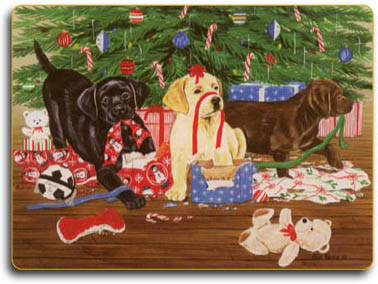 Can You Spot The Holiday Hazards?
Can You Spot The Holiday Hazards?
It’s easy for pets, especially Labradors, to get into trouble during the holidays. You may get so busy that you lose track of what is going on with your dog.
Click here to learn more about: "Can You Spot The Holiday Hazards?"
 Can You Spot The Holiday Hazards?
Can You Spot The Holiday Hazards?It’s easy for pets, especially Labradors, to get into trouble during the holidays. You may get so busy that you lose track of what is going on with your dog.
Click here to learn more about: "Can You Spot The Holiday Hazards?"
Wanted: Models

Would you like to see your Lab pictured here? Send us images of your Lab and we may include them on our Home Page!

Would you like to see your Lab pictured here? Send us images of your Lab and we may include them on our Home Page!
Labrador Library
Labrador Links
The Verstaile Lab
History of the Lab
Advice
Travel
Featured Labs
Featured Artists
Labrador Links
The Verstaile Lab
History of the Lab
Advice
Travel
Featured Labs
Featured Artists
.jpg)

